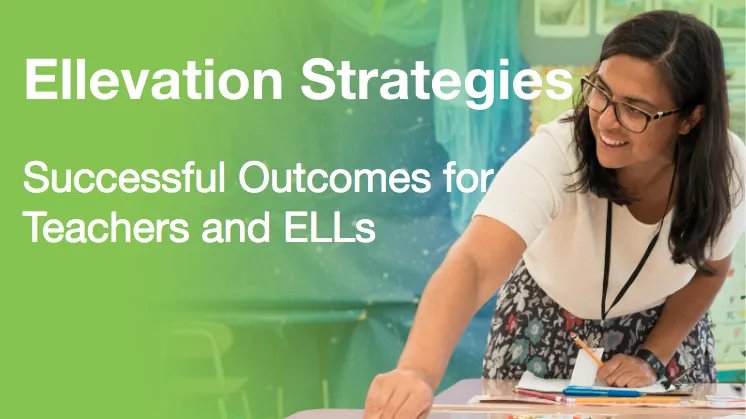Ellevation Strategies: Successful Outcomes for Teachers and ELLs


Ellevation Strategies: Successful Outcomes for Teachers and ELLs
What are the keys to engaging teachers to improve outcomes for ELLs? Recently we had an opportunity to learn from Jana Beth Francis, Assistant Superintendent of Teaching and Learning at Daviess County Schools in western Kentucky. Jana Beth oversees professional development and innovation in the district. Like many other districts in Kentucky and across the United States, Daviess is experiencing a significant shift in student demographics - including a growing ELL population. During our webinar we learned about four common challenges that districts face and how Daviess is working to overcome them while creating positive impact for ELs.
Changing Culture
The first challenge that Jana Beth needed to confront was the idea that ELLs are someone else’s students. “We had this idea that those kids were somebody else’s. We saw a real disconnect between this idea that those students belong to everyone in the school - especially the classroom teacher.” This is certainly not uncommon in districts like Daviess across the country. “When you’re a district that has a growing population of English Learners, it's hard to understand that the demographics of your school are changing and it's not someone else’s responsibility.” This is where effective leadership and professional development come into play.
Jana Beth knew she had to start by coming to terms with the fact that the vast majority of teachers, regardless of their experience, were not prepared to work with ELLs. “How we support teachers is key. We have to get out of the mindset that we can do it all on our own because of the variance in teachers and the variance in students.” While some teachers in the district could identify and focus on the needs of newcomers, understanding the different needs of students that were at a level 2 or 3 was more difficult. In fact, many teachers did not know what the 4 language domains were or how to work with them to make progress. Even instructional coaches had little to no knowledge of ELLs.
Job Embedded Professional Development
Despite their lack of experience, Jana Beth viewed her teachers as the key lever for change. “We basically have a teaching force that had no formal training in working with ELLs. We knew that if we were going to give teachers ownership, we had to make sure they were ready to work with them.” She encouraged them to take advantage of Ellevation’s features to quickly find out more about who their students were and what they needed. By providing the level of support each student needed, Ellevation removed a lot of the guesswork that had prevented teachers from gaining a clear perspective of student needs.
Ellevation’s 6 practices of the Instructional Framework brought a common language to teachers at Daviess. “If my teachers can identify at least these six practices, then I know they’re thinking about them when they’re planning lessons and really focusing on them in a way they never had before. That common language starts to get everybody to be able to share with each other.”
Supporting Scaffolded Instruction
With a new understanding of ELLs and their needs through conversation and professional development, Jana Beth began reflecting on scaffolding in her district. Ellevation helped eliminate some of the guesswork when it came to specific scaffolding strategies for ELLs.
“What I love about Ellevation is that it starts to get you thinking about what supports student need, not this idea that everybody needs the same support. It takes some of the guessing out of that for teachers.” The support levels provided by Ellevation also allows teachers to think about what changes should be made based on language domains. A key question was “how are we going to instructionally group our students and be aware of the levels of supports they need?” It was also a great opportunity for the teacher to bring in the day to day knowledge into the equation and find out if the data reflects what she is seeing in the classroom. “You’re not scaffolding just because they’re ELLs, you’re actually thinking about the support you need.”
Academic Conversations
When Daviess County’s WIDA ACCESS results came back, the data confirmed the gut feeling that educators had about their ELL students not speaking enough in their classes. Speaking scores were lower than writing scores in almost every grade level. Jana Beth knew they had to improve their students’ academic conversation skills. In many classrooms around Daviess, this would later take shape with the help of Ellevation activities like Directed Discourse, in which students engage in authentic academic conversations with peers.
But first, Jana Beth needed to provide school leaders an easy way to see if teachers were making progress on having students speak. “When I’m getting ready to focus on a major issue across the district, I look for something that is easily recognizable across the board. To me, increasing academic conversation is an easy mark.”
By using the Fostering Interactions practice in the Instructional Framework, teachers had ready access to scaffolded activities that school leaders could observe. Administrators could then walk into classrooms and quickly observe who was doing the talking in the class. Teachers had a wealth of resources at their disposal within the activities. They began using the downloads within the activity as well as learning targets, how to resources, and grade level examples - all embedded within each activity. More importantly, they observed students using academic conversation starters like, “Let me see if I heard you right…” and “That reminds me of…”.
Next Steps
Like all great school districts, Daviess County never stops learning. Jana Beth has created a plan to leverage Ellevation to better engage principals around the six practices, set goals for teachers to recommend activities, and gain a better understanding of how to encourage growth for students who have plateaued.
Stay tuned for an update from Jana Beth in a follow up webinar coming this fall.